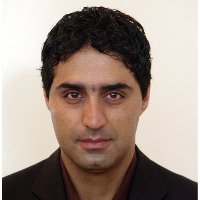Minimal Visual Elements, Maximum Critics: A Study on the Critical Approach of Daniel Buren Art
Daniel Buren is a well-known French visual artist in the international scene. He started his artistic work in the late 60s and during more than forty years of artistic activity, he relied only on a simple visual element consists of vertical alternating white and colored stripes. In contrast to the Minimalism, Buren’s art has dealt with different aspects of the art world and has been assumed a critical approach against the huge number of the most important cultural institutions such as museums and the art financial mechanisms. The main character of his art is to intervention in space by creating an artwork which will put the spectator in a critical position against the condition of the presentation of the artwork. By imposing itself in space and by passing the rules that establish it, Buren's art shows the forces that forged our world. The main question in the present paper targeted the critical side of Buren art; in this regard, the questions are mostly about the relationship between the art work and the place, how to display and the position of the audience about it and his presence in the place in relation to the architecture. This research regards to the basis of Buren Art concepts, with an analytical approach to its important critical aspect, tries to show the various aspects of the function of the elements of his art and its effects. To this end, the paper presents a historical picture of neo-avant-garde tendencies in the 1960s. The study of these movements shows a kind of abstinence and simplicity in the artistic expression of the artists of this period. This is a result of the conceptualization of art. This less expressing of means of artistic expression show itself in different ways; his expressions of own, his gestures, his approach to the subject, material or media. This tendency which caused the minimalism in the united states will emerge in movements such Arte Povera in Europe, as well as in some nouveau-realists. The BMPT group, of which Buren was a key member, was formed on the basis of a similar trend, whose basic principle was the economy of visual elements. Minimizing the visual element in Buren's work by referring to colored same size tapes, made it possible for him to eliminate the illusion that was one of the ancient functions of painting and allowed the spectator to see the artworks in a neutral context. Such a view, free from unnecessary visual elements, facilitated the possibility of taking a critical position. Another important element of Buren's art that this article tries to explain is the concept of authenticity. By creating non-transferable or reproducible artworks, Buren explores the fundamental issue of authenticity that is in relation to the ownership and commodity value. Buren's works are thought and realized in the particular places. The transfer of ownership of these works is one of the artist's critical discourses. To this end, by defining special contracts, he tries to have some kind of control over his work of art even after handing. Therefore, determining the authenticity of artist's work does not depend on the market, but on the conditions that the artist defines. So, renouncing the conditions defined by the artist will cause the loss of authenticity of his work. Finally, the article deals with one of the most important keywords of the artist's innovative words, which is the concept of "in situ". Buren's work puts the spectator in a special interaction with spatial elements. These elements include facade, landscape, frame, point of view and architecture. In these works, we observe the artist's ironic tone to the elements that form our vision field in a certain place. It can be seen that each of the operations performed by the artist highlights an invisible aspect of the work's spatial context. The result of this research discusses the critical discourses resulting from the artist's actions, which, by changing the function or imposing processes on the work, clearly aim to challenge the performance of institutions (cultural, public, economic, etc.) which determine the presentation of artwork.
- حق عضویت دریافتی صرف حمایت از نشریات عضو و نگهداری، تکمیل و توسعه مگیران میشود.
- پرداخت حق اشتراک و دانلود مقالات اجازه بازنشر آن در سایر رسانههای چاپی و دیجیتال را به کاربر نمیدهد.





